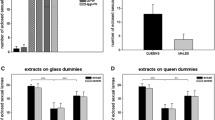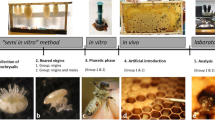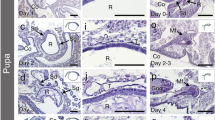Abstract
The study of morphological features of highly eusocial bees has helped to answer a series of questions concerning their biology. The labor division places the females into two castes, queen with reproductive function and worker with a wide variety of tasks. However, in different species and under different conditions, workers can develop ovaries and lay trophic eggs that are eaten by the queen or used to originate males. In this work, the development of the oviducts was monitored in workers and virgin queens of Melipona quadrifasciata anthidioides specimens of different ages to verify whether there is permanent sterility of these queens and workers due to aging. Lateral and common oviducts of virgin queens aged <7, 10, 15, 20, and 25 days old, physogastric queens, nurse, and forager workers were analyzed for histology and ultrastructure. Although the structural organization of the lateral and common oviducts were very similar, differences in width of the cuticle and the degree of chromatin condensation were observed, indicating differences in the development of this organ of the reproductive system between the castes. It was also demonstrated that electron-lucent vesicles appear to be related to the formation of the cuticle that lines the oviducts. Because no cellular death characteristics were found, it can be inferred that the absence of mating of the queens as old as of 25 days of age does not cause permanent sterility.




Similar content being viewed by others
References
Alberts B, Johnson A, Lewis J, Raff M, Roberts K, Walter P (2009) Molecular biology of the cell, 5th edn. Garland Publishing, New York
Bell WJ, Bohm MK (1975) Oosorption in insects. Biol Rev 50:373–396
Boleli IC, Simões ZLP, Bitondi MMG (1999) Cell death in ovarioles causes permanent sterility in Frieseomelitta varia workers bees. J Morphol 242:271–282
Boleli IC, Simões ZLP, Bitondi MMG (2000) Regression of the lateral oviducts during larval–adult transformation of the reproductive system of Melipona quadrifasciata and Friesomelitta varia. J Morphol 243:141–151
Büning J (1994) The insect ovary: ultrastructure, previtellogenic growth and evolution. Chapman and Hall Publishing, London
Buschini MLT, Campos LAO (1995) Caste determination in Trigona spinipes (Hymenoptera, Apidae): influence of the available food and juvenile hormone. Rev Bras Biol 55:121–129
Camargo CA (1972) Determinação de castas em Scaptotrigona postica Latreille (Hymenoptera, Apidae). Rev Bras Biol 32:133–138
Campos LAO, Coelho CDP (1993) Determinação de sexo em abelhas: determinação de castas em Partamona cupira helleri (Hymenoptera, Apidae, Meliponinae). Rev Bras Zool 10:449–452
Campos LAO, Costa MA (1989) Determinação do sexo em abelhas XXVII: determinaçao de castas em Schwarziana quadripunctata. Rev Bras Biol 49:121–123
Chapman RF (1998) The insects: structure and function. American Elsevier Publ Co, New York
Cruz-Landim C (2009) Abelhas: morfologia e função de sistemas. Editora UNESP, São Paulo
Cruz-Landim C, Reginato RD, Imperatriz-Fonseca VL (1998) Variation on ovariole number in Meliponinae (Hymenoptera, Apidae) queen’s ovaries, with comments on ovary development and caste differentiation. Pap Avul Zool 40:289–296
Engelmann F (1970) The physiology of insect reproduction. Pergamon, New York
Hatakoshi M (1992) An inhibitory mechanism over oviposition in the tobacco cutworn, Spodoptera litura by juvenile hormone analogue pyriproxyfen. J Ins Physiol 38:793–801
Lisboa LCO, Serrão JE, Cruz-Landim C, Campos LAO (2005) Effect of larval food amount on ovariole development in queens of Trigona spinipes (Hymenoptera, Apinae). Anat Histol Embryol 34:179–184
Martins GF, Serrão JE (2004) A comparative study of the ovaries in some Brazilian bees (Hymenoptera, Apoidea). Pap Avul Zool 44:45–53
Michener CD (1974) The social behavior of the bees. A comparative study. Belkman, Cambridge
Michener CD (2000) The bees of the world. Johns Hopkins Univ Press, Baltimore
Patrício K, Cruz-Landim C (2002) Mating influence in the ovary differentiation in adult queens of Apis mellifera L. (Hymenoptera, Apidade). Braz J Biol 62:641–649
Patricio K, Cruz-Landim C (2007) Effect of mating delay in the ovary of Apis mellifera L. (Hymenoptera, Apidae) queens: histological aspects. Braz J Morphol Sci 24:25–28
Rachinsky A, Strambi C, Strambi A, Hartfelder K (1990) Caste and metamorphosis: hemolymph titers of juvenile hormone and ecdysteroids in last instar honeybee larvae. Gen Comp Endocrinol 79:8–31
Snodgrass RF (1956) The anatomy of honey bee. Comstock Publ Ass, Ithaca
Souza EA, Neves CA, Campos LAO, Zanuncio JC, Serrão JE (2007) Effect of mating delay on the ovary of Melipona quadrifasciata anthidioides (Hymenoptera: Apidae) queens. Micron 38:471–477
Souza EA, Campos LAO, Neves CA, Zanuncio JC, Serrão JE (2008) Effect of delayed mating on spermathecal activation in Melipona quadrifasciata anthidioides (Hymenoptera, Apidae) queens. Apidologie 39:293–301
Stefanini M, Demartino C, Zamboni L (1967) Fixation of ejaculated spermatozoa for electron microscopy. Nature 216:173–174
Tambasco AJ (1970) Estudo sobre o desenvolvimento do ovário de rainhas de Melipona quadrifasciata anthidioides, Lepeletier e Apis mellifera adansonii Latreille (Hymenoptera, Apidae). Thesis, FFCLRP-USP, Ribeirão Preto
Telfer WH (1965) The mechanism and control of yolk formation. Annu Rev Entomol 10:161–184
Wheeler D (1996) The role of nourishment in oogenesis. Annu Rev Entomol 41:407–431
Acknowledgments
This research was supported by Brazilian Research Agencies National Council of Research (CNPq) and Minas Gerais State Research Agency (FAPEMIG).
Conflict of interest
We declare that there are no conflict of interest with the organization that sponsored the research.
Author information
Authors and Affiliations
Corresponding author
Additional information
Handling Editor: Pavel Dráber
Rights and permissions
About this article
Cite this article
Serrão, J.E., Naves, A.P. & Zanuncio, J.C. Modifications in the oviducts of workers and queens of Melipona quadrifasciata anthidioides (Hymenoptera: Apidae) with different ages. Protoplasma 248, 767–773 (2011). https://doi.org/10.1007/s00709-010-0245-2
Received:
Accepted:
Published:
Issue Date:
DOI: https://doi.org/10.1007/s00709-010-0245-2




